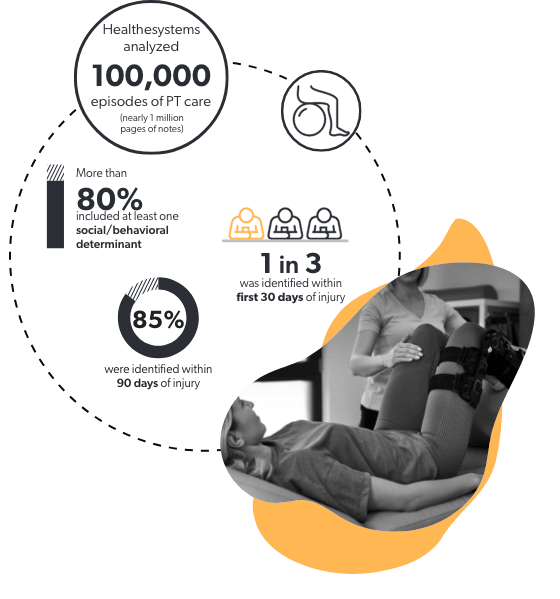More than 50% of Americans will be diagnosed with a mental illness or disorder at some point in their lifetime, while one in five will experience a mental illness each year.1 And since the COVID-19 pandemic began, mental illness has been on the rise. In 2020 alone, there was a 27.6% increase in cases of major depressive disorder and a 25.6% increase in cases of anxiety disorders worldwide.2
When it comes to workers’ compensation, this trend is especially concerning because mental/behavioral health is tied to physical health. A study of workers who missed at least five days of work due to work-related musculoskeletal injuries showed that half frequently felt symptoms of depression in the year following their injuries. And almost 10 percent of employees were diagnosed with depression at some point during the 12 months following the injury.3
Not only does a mental health condition on top of another injury or chronic condition increase claim durations and medical costs, but it can also make it difficult for an injured worker to recover and ultimately lead to poorer health outcomes.
This connection between physical and behavioral health opens a golden opportunity for physical therapists (PTs) to address mental health, especially in the first six months following an injury.4 As the provider who likely spends the most face-to-face time with injured worker patients, the PT is well positioned to gain insight into behavioral or mental health concerns that are impacting recovery.
Outpatient physical therapy clinics generally schedule for 60-minute initial evaluations. During this time the evaluating PT reviews the injured worker’s medical history, including medications, as well as observes his or her movement patterns, affect, attitudes, and behaviors.
The interaction inherent to the initial evaluation provides clues to the injured worker’s state of mind and can lead to a more directed conversation – and possibly screening – for behavioral health conditions.”
Tate Rice, PT, DPT, MBA
Director of Product Management, Clinical at Healthesystems
According to Tate Rice, PT, DPT, MBA and Director of Product Management, Clinical for Healthesystems, “The interaction inherent to the initial evaluation provides clues to the injured worker’s state of mind and can lead to a more directed conversation – and possibly screening – for behavioral health conditions.”
In 2020, the American Physical Therapy Association House of Delegates affirmed this idea and passed a position stating, “It is within the professional scope of the physical therapist practice to screen for and address behavioral and mental health conditions in patients, clients, and populations.”5
Physical, behavioral, and mental health are inseparably interconnected within overall health and well-being. Mental health problems, such as depression, anxiety, and PTSD, may hinder physical healing; a full recovery often means both physical and emotional healing.
For injured workers, the negative impacts of mental health conditions include:

Data from the Workers Compensation Research Institute shows that injured workers are spending more and more time in the PT’s office. In 2011, 56% of lost time claims included outpatient physical medicine services (i.e., physical therapy). By 2017, the median was up to 63% with some states like California and New Jersey even higher at more than 70%.12 And a Healthesystems analysis of approximately 100,000 PT episodes of care reveals that the average injured worker patient spends six to 12 hours with their PT over one episode of care.13
Simply because they spend so much time with injured workers, PTs are in the best position to detect mental health concerns. However, recognizing depression can be particularly difficult in people with a physical illness.14 That’s because some symptoms, such as fatigue, changes in appetite, and insomnia, are common in both depression and many medical conditions.
PTs get around this and pinpoint the signs of mental illness by using screening tools such as the Depression Anxiety Stress Scales and Patient-Reported Outcomes Measurement Information System. Another tool, the Orebro Musculoskeletal Pain Questionnaire, specifically identifies which candidates are at risk of delayed recovery. The questionnaire is comprised of questions regarding pain, perception of daily living activities and work, and behavior that occurs in response to pain, beliefs, and attitudes.
Upon discovering the presence of a mental illness, PTs should inform the appropriate stakeholders and refer the injured worker to a specialist who will provide the proper behavioral treatment. In doing so, they may be ensuring behavioral care for someone who would otherwise not seek or receive it. Studies show that only one-third of people with depression in high-income countries receive formal mental health care.15
When left undetected and/or untreated, mental illness can lead to grave consequences for injured workers. It can result in unnecessary disability, unemployment, substance abuse, homelessness, inappropriate incarceration, poor quality of life, and suicide. In a study of 100,000 injured workers, lost-time injuries were associated with a 92% increase in the risk of deaths from suicide for women and a 72% increase for men.16
Early detection and treatment are vitally important to the well-being of injured worker patients who may suffer mental illness, and this is exactly where the physical therapist can help.
“As a practicing therapist for more than 20 years, I can attest to behavioral health affecting care,” says Rice. “There have been numerous examples of injured workers suffering from depression and/or anxiety, abusing alcohol or illicit substances, or lacking the social supports necessary for optimal recovery.”
Even when the PT does not directly refer a worker patient for behavioral services, the information they document during their one-on-one interactions can be just as useful in helping payers and other stakeholders identify at-risk patients who could benefit from these services. With each episode of PT care resulting in more than 50 pages of documentation, PT notes serve as a valuable source of insight – especially when artificial intelligence-driven technology is in place to aggregate and analyze the data.
Healthesystems performed such an analysis of 100,000 episodes of PT care comprising nearly one million pages of notes from initial and follow-up PT evaluations – among them functional assessment questionnaires, including the Orebro, as well as other documentation. In that analysis, more than 80% of claims included at least one social or behavioral determinant, and the data shows these factors can be identified very early.
Approximately one in three of those claims with a social or behavioral determinant was identified within the first 30 days of injury through data captured at the initial evaluation, and 85% were identified within 90 days of injury.17 Notably, these social and behavioral determinants were associated with prolonged treatment durations, in much the same way that poor functional assessment scores were associated with prolonged treatment durations.

Cura personalis, a Latin phrase meaning “care for the entire person,” is a guiding principle in the physical therapy profession. Physical therapists know that unmet behavioral needs can lead to poorer health outcomes. That is why they treat the whole person – rather than just the physical disability the person is experiencing – using a holistic approach. A holistic approach combines the traditional methods of injury recovery with techniques such as chiropractic care, massage, nutrition, and a structured fitness routine.
Exercise therapy has been proven to improve both mental and physical health in patients with major depression. Doing 30 minutes or more of exercise a day for three to five days a week may significantly improve depression or anxiety symptoms. And even smaller amounts of physical activity – as little as 10 to 15 minutes at a time – may make a difference.18 For mild to moderate depression, the effect of exercise may be comparable with antidepressant medication and psychotherapy.19
For injured worker patients, the PT will determine what exercises are appropriate through a physical examination completed during the initial evaluation. Adjustments to those exercises will be made primarily on the patient’s physical response and overall progress.
Physical therapy plays an important part in recovery for injured workers, but the role of the physical therapist goes beyond healing physical injuries. As the provider who may spend the most time with injured workers, the physical therapist has a golden opportunity to gain insight into their patients’ behavioral or mental health concerns and positively impact recovery.
